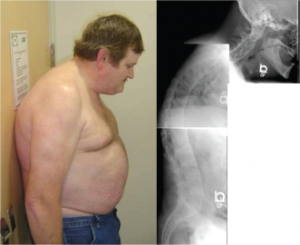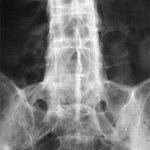“Can you touch your toes without bending your knees?” I squatted down behind him and placed my thumbs over the upper aspect of his sacroiliac joints. “Wait, I’m going to put two marks on your back before you bend forward.”
Michael reached for the floor, but his fingertips extended only to his mid-calves. “Not so good,” I noted. “Can you try that again? Keep your knees straight and give me your best effort.” This time, I measured the distance that his lumbar spine distracted between the two points I had marked. It barely budged. The test, a Schober’s maneuver, measured 1 cm. Clearly abnormal.
I hung the MRI up on the view box and agreed that the changes of congenital spinal stenosis were minimal. But where the MRI image extended into the sacroiliac joints was the answer. Both sides of the SI joints demonstrated definite changes of inflammation.
Both young men, Joshua and Michael, had ankylosing spondylitis. In one, the disease tore through the tissues like an unrelenting malignancy. In the other, the disease smoldered in place with only the subtlest of signs: MRI evidence of sacroiliac inflammation. Well, not quite. I had noticed that the left pupil was dilated slightly more than right, so I asked Michael if he had problems with the eye.
“You mean the iritis, which keeps coming back?” Sure. “My dad has the same thing. In fact, it’s the same eye. Weird, huh? But he’s lucky, he hasn’t ever had a shred of back pain. Lucky guy.”
Back to the Present Case
I re-entered the exam room and focused on the present task: Josh’s huge knee effusions. When I entered the right knee with a 16 gauge needle, there was so much pressure, my 50 cc syringe filled almost immediately. Joanne handed me another syringe, then another and another. Before I was done, six full syringes—300 cc—of amber fluid had been removed from the diseased knee. Another 250 cc was aspirated from the left knee, another record.
Even after the fluid had been aspirated from the knees, an audible grating, clunking sound occurred as I tried to flex and extend them. I hung up the films that Joshua had brought from Maine Medical Center. More bad news. From the pelvis to the neck, the spine was fused in a forward flexed position: a bamboo spine. The sacroiliac joints were fused. The hip joints were narrowed. For the first time in my practice career, I decided to admit a patient, an 18-year-old patient, for inflammatory arthritis.
In recent years, several studies have assessed whether altering the bacterial biome of the gut may lead to clinical improvement in ankylosing spondylitis. … But probiotics alone may not be the answer.
Ankylosing Spondylitis

This 48-year-old man with ankylosing spondylitis has marked restriction in cervical spine range of motion. The composite of the cervical, thoracic and lumbar spine radiographs show syndesmophytes bridging adjacent vertebrae throughout the spine.
ACR IMAGE BANK



